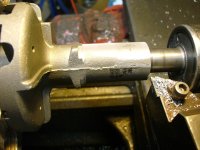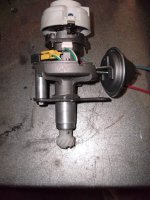First time posting here so if I break a rule, go easy on me  .
.
Anyway, I recently bought an old Clark C300-40 forklift with a Continental Y112 4-cyl that ran good when I bought it and just needed the lift cylinder repacked. I got that done and on a quick test run it ran good about halfway up my driveway then started running real rough, plus it was making a noise like when you've got a bearing on a skateboard going bad, and a little metallic tick, tick, tick. It would stop for about 30 seconds, then start again. I thought I was having a nightmare and the engine had wiped a bearing at first, but it had good oil pressure the whole time and the tick noise wasn't loud enough to be a knock. It was coming from the center of the engine where the distributor is, so I pulled off the distributor cap and everything looked good until I touched the rotor. It moved back and forth about 1/4" and would rotate about 15-20 degrees, so just worn right out on the bushing and the drive pin. Tick noise was the rotor hitting the cap terminals. While the cap was off, I squirted some oil down the shaft to see if the squalling noise would quiet. It did, but it continued to run rough intermittently. Time for a new distributor.
Saw this post here https://www.practicalmachinist.com/forum/posts/855029/ and thought the upgrade to a Pertronix electronic distributor was a good idea considering that it seems to be the only aftermarket unit available and I really don't like dealing with points. Bought the D41-05A unit for my engine and here I am installing it today. Installed new unit, hooked up red to positive and black to negative on the coil as per the instructions, swapped on a new set of spark plug wires, cranked over and no fire. Checked for spark, no spark.
So here's what I've done so far for troublesooting:
I've done a decent amount of reading on this and I'm thinking one of two things:
 .
. Anyway, I recently bought an old Clark C300-40 forklift with a Continental Y112 4-cyl that ran good when I bought it and just needed the lift cylinder repacked. I got that done and on a quick test run it ran good about halfway up my driveway then started running real rough, plus it was making a noise like when you've got a bearing on a skateboard going bad, and a little metallic tick, tick, tick. It would stop for about 30 seconds, then start again. I thought I was having a nightmare and the engine had wiped a bearing at first, but it had good oil pressure the whole time and the tick noise wasn't loud enough to be a knock. It was coming from the center of the engine where the distributor is, so I pulled off the distributor cap and everything looked good until I touched the rotor. It moved back and forth about 1/4" and would rotate about 15-20 degrees, so just worn right out on the bushing and the drive pin. Tick noise was the rotor hitting the cap terminals. While the cap was off, I squirted some oil down the shaft to see if the squalling noise would quiet. It did, but it continued to run rough intermittently. Time for a new distributor.
Saw this post here https://www.practicalmachinist.com/forum/posts/855029/ and thought the upgrade to a Pertronix electronic distributor was a good idea considering that it seems to be the only aftermarket unit available and I really don't like dealing with points. Bought the D41-05A unit for my engine and here I am installing it today. Installed new unit, hooked up red to positive and black to negative on the coil as per the instructions, swapped on a new set of spark plug wires, cranked over and no fire. Checked for spark, no spark.
So here's what I've done so far for troublesooting:
-Checked voltage at the coil positive terminal to make sure it's not starving for voltage from a ballast resistor. 12.8 volts at the coil. Strong battery and very little resistance in the line.
-I re-read the instructions and found that they mentioned primary resistance in the coil being an issue. For a 4-banger they want 3.0 ohms primary resistance, or to add a resistor on the positive side to bring it up to 3.0+ ohms. Mine measured as 1.5 ohms primary resistance, so I added a ballast resistor between the coil positive and the distributor positive which brought it up to ~3.5 ohms of total resistance. Still no spark.
-Pertronix instructions didn't show any wiring beyond their install, so I checked a diagram online of a typical GM ignition setup and I found that it didn't have a chassis ground going to the coil negative terminal which was how this setup was wired when I took it apart. Only a positive wire to the distributor was present along with a chassis ground on the negative side of the coil. The GM diagram had a negative wire going to the coil and no chassis ground, and I read elsewhere that this will prevent spark, so I removed the chassis ground from the negative side of the coil and attached just the black wire from the distributor to it. Still no spark.
-Just to make sure my positive lead wasn't giving me intermittent problems, I made up a test lead wired directly between battery positive to the coil positive. Still no spark.
I've done a decent amount of reading on this and I'm thinking one of two things:
- Because I had this wired wrong from the start, I maybe burned up the electronics in the distributor. Would improper resistance on the coil or grounding the negative terminal to chassis ground cause that? Bear in mind that it had good spark with the old points distributor and that this unit has maybe 10 minutes total time in which it had current running through it, and no more than a couple minutes continuous.
- I got a dud. I'm leaning towards this one because from what I can gather, even poorly wired units will run fine for awhile then burn up, but they'll at least fire up and run at first. I had zero spark at any point.





